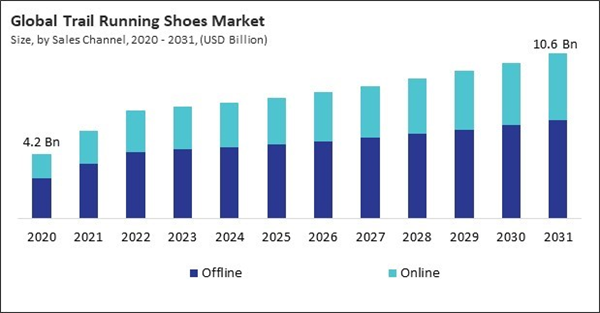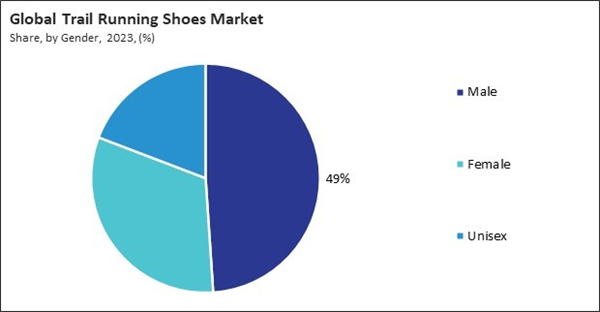The Global Trail Running Shoes Market size is expected to reach $10.6 billion by 2031, rising at a market growth of 5.2% CAGR during the forecast period. In the year 2023, the market attained a volume of 72.69 million units, experiencing a growth of 21.3% (2020-2023).
Europe is renowned for its diverse and scenic landscapes, from the Alps and Pyrenees to the vast forests and coastal trails, which attract trail runners of all skill levels. The popularity of trail running events, such as ultramarathons and mountain races, has surged in recent years, further boosting the demand for high-quality trail running shoes. Hence, the Europe segment acquired 31% revenue share in the market in 2023. In terms of volume, the region is expected to utilize 33.38 million units of trail running shoes by the year 2031. European consumers strongly emphasize sustainability and environmentally friendly products, prompting manufacturers to innovate and produce eco-friendly trail running shoes.
Trail running has emerged as one of the most popular outdoor activities, combining the benefits of running with the scenic and often challenging environments of natural trails. This activity is appealing to a significant number of individuals due to its potential to provide physical exercise and mental health benefits, including enhanced mood and stress reduction. The increased popularity of trail running is reflected in the participation statistics. Hence, the growing participation in outdoor activities is a major factor propelling the growth of the market.
Furthermore, Manufacturers continually innovate to improve trail running shoes' performance, durability, and comfort, making them more appealing to consumers. These technological enhancements address the specific needs and challenges faced by trail runners. One of the key technological advancements in trail running shoes is the development of enhanced grip and traction. Trail running often involves navigating uneven, slippery, and rugged terrains, making traction a critical feature. Thus, the continuous evolution of shoe technology not only attracts seasoned trail runners but encourages new participants to explore trail running, contributing to the expanding market.
However, the market has been dominated by a multitude of well-established brands for an extended period, resulting in a significant barrier to entry for new companies. These established brands, such as Salomon, Hoka One, and Merrell, have built strong reputations and loyal customer bases. Their extensive product lines, marketing strategies, and established distribution channels give them a significant advantage. In addition to these established actors, the market is constantly being disrupted by new entrants who are attempting to establish a niche. Hence, the high level of competition in the market presents challenges.
Europe is renowned for its diverse and scenic landscapes, from the Alps and Pyrenees to the vast forests and coastal trails, which attract trail runners of all skill levels. The popularity of trail running events, such as ultramarathons and mountain races, has surged in recent years, further boosting the demand for high-quality trail running shoes. Hence, the Europe segment acquired 31% revenue share in the market in 2023. In terms of volume, the region is expected to utilize 33.38 million units of trail running shoes by the year 2031. European consumers strongly emphasize sustainability and environmentally friendly products, prompting manufacturers to innovate and produce eco-friendly trail running shoes.
Trail running has emerged as one of the most popular outdoor activities, combining the benefits of running with the scenic and often challenging environments of natural trails. This activity is appealing to a significant number of individuals due to its potential to provide physical exercise and mental health benefits, including enhanced mood and stress reduction. The increased popularity of trail running is reflected in the participation statistics. Hence, the growing participation in outdoor activities is a major factor propelling the growth of the market.
Furthermore, Manufacturers continually innovate to improve trail running shoes' performance, durability, and comfort, making them more appealing to consumers. These technological enhancements address the specific needs and challenges faced by trail runners. One of the key technological advancements in trail running shoes is the development of enhanced grip and traction. Trail running often involves navigating uneven, slippery, and rugged terrains, making traction a critical feature. Thus, the continuous evolution of shoe technology not only attracts seasoned trail runners but encourages new participants to explore trail running, contributing to the expanding market.
However, the market has been dominated by a multitude of well-established brands for an extended period, resulting in a significant barrier to entry for new companies. These established brands, such as Salomon, Hoka One, and Merrell, have built strong reputations and loyal customer bases. Their extensive product lines, marketing strategies, and established distribution channels give them a significant advantage. In addition to these established actors, the market is constantly being disrupted by new entrants who are attempting to establish a niche. Hence, the high level of competition in the market presents challenges.
Driving and Restraining Factors
Drivers- Increasing Participation in Outdoor Activities
- Innovative Advancements in Shoe Technology
- Rising Popularity of Trail Running Events
- High Competition in The Trail Running Shoes Market
- Substantial Costs of Trail Running Shoes
- Growing Awareness of Health and Fitness
- Rapid Expansion of Retail Channels
- Significant Challenges Posed by Brand Loyalty
- Limited Consumer Awareness About the Benefits of Trail Running Shoes
Type Outlook
Based on type, the market is characterized into light trail running shoes, rugged trail running shoes, off trail running shoes, and others. The light trail running shoes segment garnered 41% revenue share in the market in 2023. In terms of volume, 50.11 million units of light trail running shoes are expected to be utilized by the year 2031. One of the key factors that is driving the expansion of the light trail running shoe sector is the increasing popularity of trail running among athletes who participate in trail running for leisure purposes.Gender Outlook
On the basis of gender, the market is classified into unisex, male, and female. The female segment recorded 32% revenue share in the market in 2023. In terms of volume, it is expected that 39.30 million units of trail running shoes for female would be utilized by the year 2031. The promotion of outdoor activities among women and a shift toward gender inclusivity are the primary factors driving this growth. In response, manufacturers have developed trail running shoes that are specifically intended to fulfill the specific anatomical requirements of female runners. These shoes offer a more comfortable fit, designs that are appealing, and a better fit overall.Sales Channel Outlook
By sales channel, the market is divided into online and offline. The offline segment witnessed 62% revenue share in the market in 2023. In terms of volume, 67.19 million units of trail running shoes are expected to be sold through offline channel by the year 2031. One of the key advantages of the offline segment is the ability for consumers to try on shoes and ensure the proper fit and comfort before making a purchase. Trail running shoes, which need support, durability, and protection on rugged terrains, often require a precise fit that consumers prefer to assess in person.Regional Outlook
Region-wise, the market is analyzed across North America, Europe, Asia Pacific, and LAMEA. The North America segment procured 36% revenue share in the market in 2023. In terms of volume, 41.03 million units of trail running shoes in this region by the year 2031. The region boasts a well-established culture of outdoor activities and adventure sports, with trail running being a popular pursuit among fitness enthusiasts and athletes alike. The presence of vast natural landscapes, including national parks and dedicated trail systems, provides ample opportunities for trail running, further fueling the demand for specialized footwear.Recent Strategies Deployed in the Market
- May-2024: Skechers partnered with John Deere, recognized by its iconic leaping deer logo, are uniting to expand across work, outdoor, and fashion sectors globally with a collaborative professional and lifestyle footwear collection. With this partnership, the company developed this offering to meet consumer demands, integrating advanced technologies and durable designs adorned with their distinctive colors. This collection caters to diverse demographics eager to incorporate the Deere brand into their footwear selection.
- May-2024: Nike has unveiled two new trail running shoes, the Nike Zegama 2 and the Nike Pegasus Trail 5. The Zegama 2 targets long-distance trail runners seeking robust support for extensive journeys, delivering cushioning, stability, and support. On the other hand, the Pegasus Trail 5 boasts a distinctive design adaptable from road to trail. Its outsole is equipped with Nike Trail All Terrain Compound (ATC), a durable rubber blend engineered for enhanced grip. Similar to the Zegama 2, the Pegasus Trail 5 features a breathable mesh upper.
- Apr-2024: Nike revealed Nike Ultrafly, marking the brand's inaugural trail shoe incorporating a carbon plate in its sole. The Ultrafly is meticulously crafted for trail runners aiming to race and maneuver swiftly through trails. Nike collaborated with Vibram to create an exclusive new sole design for the Ultrafly. Its outsole showcases Vibram's Litebase technology, ensuring a lightweight and agile design, complemented by Vibram Traction Lug technology and Vibram MegaGrip compound to deliver superior traction.
- Apr-2024: Salomon introduced the GENESIS, its latest mountain running shoe that blends style with functionality. Designed for tackling rocky terrains, the shoe features a woven Matryx® upper that offers breathability and resistance to dirt. The GENESIS is available in three distinct color options for both men and women. Men can choose from Black/Sulphur/Spring, Carbon/Tahitian Tide/Quiet Shade, and Dragon Fire/Black/Cement. Women, on the other hand, have the choice of Birds of Paradise/Black/Almond Milk, Black/Sulphur Spring/Orchid Petal, and Carbon/Grisaille/Aloe Wash editions.
- Mar-2024: Reebok launched FloatZig 1 running shoes, integrating Floatride Energy Foam and Zig Tech technology into a new, lightweight, and responsive running model aimed at enhancing the enjoyment of running for everyone. By merging our acclaimed Floatride Energy Foam cushioning, originally crafted for elite runners, with our distinctive outsole design, we have developed a running shoe that delivers top-tier support and comfort. The FloatZig 1 stands out for its distinctive, bold, and stylish appearance, offering a unique blend of performance and aesthetics.
List of Key Companies Profiled
- New Balance Athletics, Inc.
- SKECHERS USA, Inc.
- Nike, Inc.
- Reebok International Ltd. (Authentic Brands Group LLC)
- Adidas AG
- La Sportiva S.p.A.
- PUMA SE (Groupe Artémis S.A.)
- Wolverine World Wide, Inc.
- Altra Running (VF Corporation)
- Salomon SAS (Amer Sports Corporation)
Market Report Segmentation
By Sales Channel (Volume, Thousand Units, USD Billion, 2020-2031)- Offline
- Online
- Male
- Female
- Unisex
- Light Trail Running Shoes
- Rugged Trail Running Shoes
- Off Trail Running Shoes
- Others
- North America
- US
- Canada
- Mexico
- Rest of North America
- Europe
- Germany
- UK
- France
- Russia
- Spain
- Italy
- Rest of Europe
- Asia Pacific
- China
- Japan
- India
- South Korea
- Singapore
- Malaysia
- Rest of Asia Pacific
- LAMEA
- Brazil
- Argentina
- UAE
- Saudi Arabia
- South Africa
- Nigeria
- Rest of LAMEA
Table of Contents
Chapter 1. Market Scope & Methodology
Chapter 2. Market at a Glance
Chapter 3. Market Overview
Chapter 5. Global Trail Running Shoes Market by Sales Channel
Chapter 6. Global Trail Running Shoes Market by Gender
Chapter 7. Global Trail Running Shoes Market by Type
Chapter 8. Global Trail Running Shoes Market by Region
Chapter 9. Company Profiles
Companies Mentioned
- New Balance Athletics, Inc.
- SKECHERS USA, Inc.
- Nike, Inc.
- Reebok International Ltd. (Authentic Brands Group LLC)
- Adidas AG
- La Sportiva S.p.A.
- PUMA SE (Groupe Artémis S.A.)
- Wolverine World Wide, Inc.
- Altra Running (VF Corporation)
- Salomon SAS (Amer Sports Corporation)
Methodology

LOADING...










